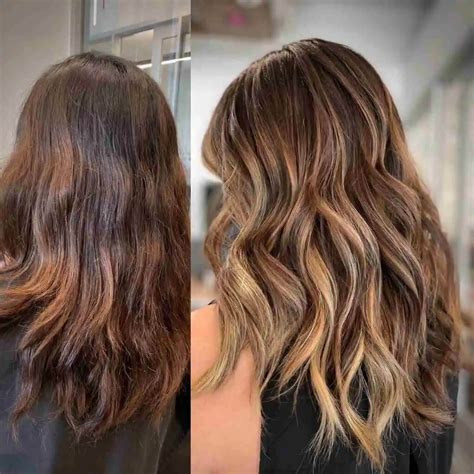Balayage Partial
Definition: A partial balayage involves highlighting only certain sections of your hair, creating a more subtle and natural-looking effect.

Benefits:
- Low-maintenance: Requires less touch-ups than a full balayage.
- Versatile: Can be customized to frame your face, add depth, or enhance your natural hair color.
- Minimal damage: Only a small portion of hair is highlighted, reducing the risk of damage.
Full Balayage
Definition: A full balayage highlights the entire head of hair, resulting in a more dramatic and sun-kissed look.
Benefits:
- High-impact: Creates a bold and eye-catching effect.
- Depth and dimension: Adds layers of color to give your hair a dimensional and dynamic appearance.
- Long-lasting: Requires less frequent touch-ups due to the extensive nature of the highlighting.
Comparing Balayage Partial vs. Full
| Feature | Balayage Partial | Balayage Full |
|---|---|---|
| Coverage | Highlights only selected sections | Highlights the entire head of hair |
| Maintenance | Lower-maintenance | Higher-maintenance |
| Damage | Less damaging | More damaging |
| Cost | Typically less expensive | More expensive |
| Effect | Subtle and natural | Dramatic and sun-kissed |
Choosing the Right Technique
The best balayage technique for you depends on your desired hair goals and lifestyle. Here are some factors to consider:
- Desired effect: A partial balayage is ideal for those who want a subtle enhancement, while a full balayage is more appropriate for those who prefer a bolder look.
- Condition of your hair: If your hair is damaged or fine, a partial balayage may be a better choice to minimize further damage.
- Time commitment: A full balayage requires more time and effort to maintain, while a partial balayage is less time-consuming.
- Budget: Full balayages tend to be more expensive than partial balayages due to the increased amount of time and product required.
Common Mistakes to Avoid
- Over-highlighting: Too much highlighting can make your hair look brassy and damaged.
- Using harsh chemicals: Strong chemicals can damage your hair’s integrity.
- DIY balayage: Balayage requires professional expertise to achieve the best results.
- Ignoring the condition of your hair: Highlighting can be drying, so it’s important to use hair care products that hydrate and protect your hair.
FAQs
1. How often should I get a balayage touch-up?
A: This depends on the technique used and how fast your hair grows. A partial balayage may require touch-ups every 4-6 months, while a full balayage may require touch-ups every 8-12 months.
2. Does balayage damage my hair?
A: Any hair coloring process can potentially damage your hair, but balayage is generally less damaging than traditional highlighting techniques.
3. What kind of hair is balayage best suited for?
A: Balayage can be used on all types of hair, but it is particularly effective on light to medium-brown hair.
4. How long does a balayage take?
A: The time required for a balayage depends on the length and thickness of your hair. A partial balayage may take 2-3 hours, while a full balayage may take 4-6 hours.
5. Is balayage more expensive than other highlighting techniques?
A: Balayage is typically more expensive than traditional highlighting techniques due to the time and skill required to create the desired effect.
6. Can I color my hair after a balayage?
A: Yes, you can color your hair after a balayage, but it is important to consult with your stylist to determine the best approach. Coloring over a balayage can alter the color results.
Innovative Applications
Reverse Balayage: A reverse balayage involves creating darker highlights on lighter hair, resulting in a shadowed and dimensional effect.
Ombré Balayage: A combination of ombré and balayage, this technique creates a seamless transition from darker roots to lighter ends, with added highlights throughout the hair.
Flamboyage: A freehand highlighting technique that uses a painting motion to create soft and subtle highlights, giving the hair a sun-kissed and natural look.
Effective Strategies
- Consult with a professional stylist: They can help you determine the best balayage technique for your hair and lifestyle.
- Use high-quality hair products: This will help protect your hair from damage and maintain the vibrancy of your balayage.
- Get regular maintenance: Touch-ups will help keep your balayage looking fresh and prevent it from becoming brassy or faded.
- Use color-protecting hair products: This will help extend the longevity of your balayage and prevent fading caused by sun exposure and heat styling.
- Avoid over-washing your hair: Frequent washing can strip away the natural oils that protect your hair and cause the balayage to fade more quickly.
